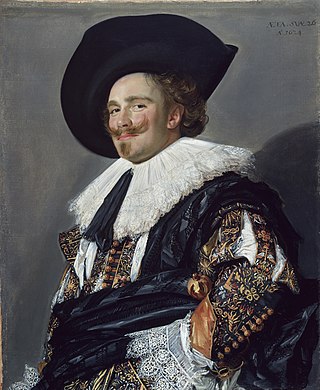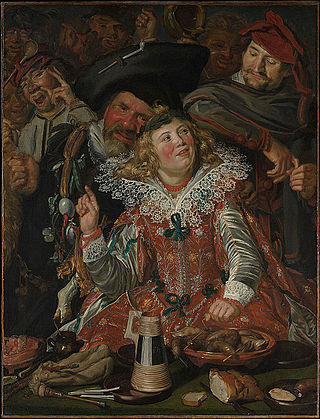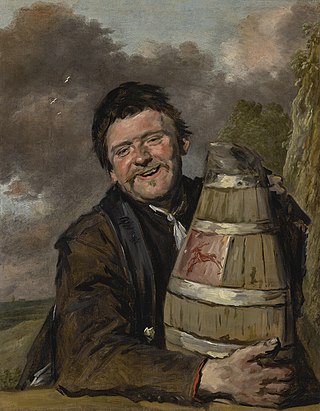
Frans Hals the Elder was a Dutch Golden Age painter. He lived and worked in Haarlem, a city in which the local authority of the day frowned on religious painting in places of worship but citizens liked to decorate their homes with works of art. Hals was highly sought after by wealthy burgher commissioners of individual, married-couple, family, and institutional-group portraits. He also painted tronies for the general market.

The Laughing Cavalier (1624) is a portrait by the Dutch Golden Age painter Frans Hals in the Wallace Collection in London. It was described by art historian Seymour Slive as "one of the most brilliant of all Baroque portraits". The title is an invention of the Victorian public and press, dating from its exhibition in the opening display at the Bethnal Green Museum in 1872–1875, just after its arrival in England, after which it was regularly reproduced as a print, and became one of the best known old master paintings in Britain. The unknown subject is in fact not laughing, but can be said to have an enigmatic smile, much amplified by his upturned moustache.

Malle Babbe is a painting by the Dutch Golden Age painter Frans Hals, painted c. 1633-1635, and now in the Gemäldegalerie, in Berlin. The painting has also been titled as Hille Bobbe or the Witch of Haarlem. It was traditionally interpreted as a tronie, or genre painting in a portrait format, depicting a mythic witch-figure. The painting is now often identified as a genre-style portrait of a specific individual from Haarlem, known as Malle Babbe, who may have been an alcoholic or suffered from a mental illness.
Seymour Slive was an American art historian, who served as director of the Harvard Art Museums from 1975 to 1984. Slive was a scholar of Dutch art, specifically of the artists Rembrandt, Frans Hals, and Jacob van Ruisdael.

Isabella Coymans, was the Dutch wife of Stephanus Geraerdts best known for her portrait painted by Frans Hals.

Pieter Biesboer, is a Dutch art historian and prolific writer on 17th-century Dutch art. His specialty is art from Haarlem.

Two Laughing Boys with a Mug of Beer is an oil-on-canvas painting by Frans Hals, created c. 1626, showing a Kannekijker (mug-looker). It hangs in the Hofje van Mevrouw van Aerden museum in Leerdam, Netherlands. It was stolen from the museum in 2020 and is still missing.

The Merry Drinker is an oil-on-canvas painting by Dutch artist Frans Hals, from c. 1628–1630. The painting has dimensions of 81 by 66.5 centimeters. It is in the collection of the Rijksmuseum, in Amsterdam.

Yonker Ramp and His Sweetheart is an oil-on-canvas painting by the Dutch Golden Age painter Frans Hals, painted in 1623 and now in the Metropolitan Museum of Art, New York City. The painting has also been titled as Young Man and Woman in an Inn or Portrait of Pieter Ramp.

Shrovetide Revellers, also known as Merrymakers at Shrovetide, is a painting by the Dutch Golden Age painter Frans Hals, painted in around 1616–17. It is one of the earliest surviving works by Hals, and has been held by the Metropolitan Museum of Art, New York City since 1913. The painting shows people festivities at Shrovetide, an annual carnival of food and jollity which takes place before the Christian fasting season of Lent.

The Gypsy Girl, also known as Gypsy Girl or Young Woman (La Bohémienne)(and sometimes erroneously referred to as Malle Babbe) is an oil-on-wood painting by the Dutch Golden Age painter Frans Hals, painted in 1628–1630, and now in the Louvre Museum, in Paris. It is a tronie, a study of facial expression and unusual costume, rather than a commissioned portrait.

Laughing Fisherboy is an oil-on-canvas painting by the Dutch Golden Age painter Frans Hals, painted in 1628 and now in Westphalia.

St. Matthew is an oil-on-canvas painting by the Dutch Golden Age painter Frans Hals, painted in 1625 and now in the Odesa Museum of Western and Eastern Art, Odesa.

St. Mark is an oil-on-canvas painting by the Dutch Golden Age painter Frans Hals, painted in 1625. It was purchased by Russian philanthropist Alisher Usmanov from the art dealer Colnaghi, London in September 2013 for the Pushkin Museum and donated by him to that museum in November that year, where it still hangs.

Laughing boy with a flute is an oil-on-panel painting by the Dutch Golden Age painter Frans Hals, painted in 1626 and now in the Staatliches Museum Schwerin, Schwerin.

The Smoker is an oil-on-panel painting by the Dutch Golden Age painter Frans Hals, painted in 1626 and now in the Metropolitan Museum of Art, New York City.

Laughing Boy with a Flute is an oil-on-canvas painting by the Dutch Golden Age painter Frans Hals, painted in the early 1620s.

Man with a Beer Jug is an oil-on-canvas painting by the Dutch Golden Age painter Frans Hals, painted in the early 1630s, now in a private collection.

Family Group in a Landscape is an oil-on-canvas painting by the Dutch Golden Age painter Frans Hals, painted c. 1645-1648, and now in the Museo Thyssen-Bornemisza, in Madrid.

Portrait of a Man is an oil-on-canvas painting by the Dutch Golden Age painter Frans Hals, painted c. 1660 and now in the Frick Collection, New York City. The man has been mistakenly identified as Michiel de Ruyter.
























